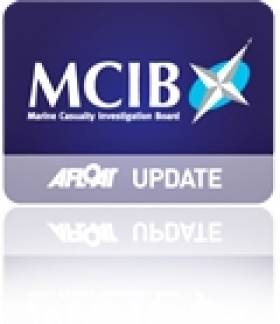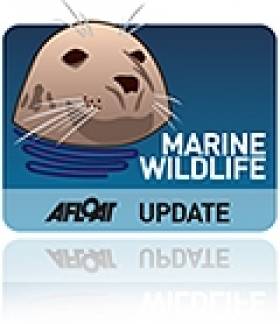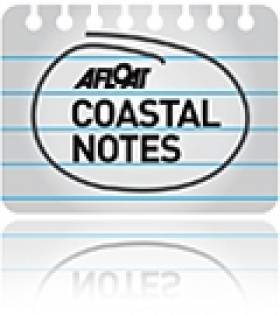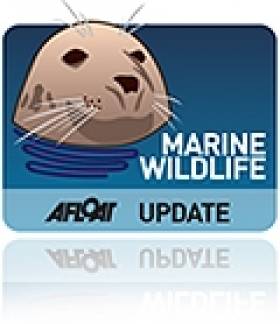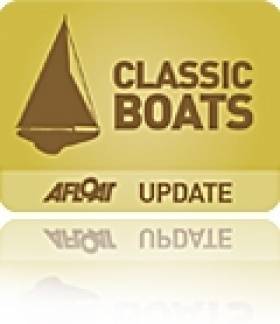Displaying items by tag: west cork
Young Kitesurfers Fly The Banner For West Cork
#Kitesurfing - West Cork is firmly behind two junior stars of the Irish kitesurfing scene, as the Southern Star reports.
Fifteen-year-old James Tidmarsh, already a four-year veteran, was victorious in the junior competition at the recent Battle for the Bay on Dollymount Strand, where his fellow West Cork kiteboarder Darragh O'Brien (10) placed joint third.
The latter result is even more remarkable given that O'Brien has been kitesurfing for less than a year, and the Battle for the Bay was his first competition.
The Southern Star has more on the story HERE.
Lack Of Experience, Absence Of Radio & Stability Issues Compounded 'Zillah' Dinghy Tragedy - MCIB Report
#Zillah - Lack of seafaring experience and the absence of a VHF radio or other means of contact compounded a tragic situation that led to the death of a retired teacher after the capsize of his dinghy off West Cork last summer, according to the official investigation into the incident.
As previously reported on Afloat.ie, an inquest into the capsize of the Drascombe Lugger Zillah returned a verdict of accidental death in the case of 66-year-old Douglas Perrin, who drowned after his vessel overturned and sent him and two companions into the water off Castle Island near Schull on the evening of 13 August last.
The court heard that guests Marian Brown and Patrick Anwyl, neither experienced sailors, were taking turns at the helm under the supervision of Perrin, a sailing instructor for more some 30 years, when the boat overturned in gusty weather.
As the report by the Marine Casualty Investigation Board (MCIB) outlines, it was found that the boat - built before the Recreational Craft Directive requirement and of a type known to have stability issues in certain conditions – gybed suddenly on the approach to the Amelia Buoy at the Schull Harbour entrance, taking all three by surprise.
The vessel quickly turned turtle, with its centreplate retracting into the stowed position, and the guests managed to clamber onto the upturned hull with Perrin in the water beside them.
However, they did not have a VHF radio or EPIRB-type beacon on the vessel, and there were no other boats in the vicinity to witness the incident not spot the casualties and attempt rescue.
Despite the mild water temperature, none of the three were wearing more than light summer clothes with their PFDs, and Perrin spoke of feeling cold within 30 minutes.
After the three attempted to swim some 50 metres to nearby rocks on Castle Island, Perrin was separated from his guests, who later saw him drifting past the island making no effort to swim but with his head above the waves.
It was many hours later into the following day, after an alert by Perrin's wife who had been expecting the group's return, that Brown and Anwyl were located and rescued by emergency responders. The body of Perrin was found a short time later off Sherkin Island.
The MCIB found that the guests' lack of sailing experience "meant that they did not react correctly to the developing situation" when the boat suddenly gybed.
Moreover, the lack of a radio, which would have immediately alerted any number of vessels in the nearby Schull area as well as emergency teams, would have likely seen all three rescued in a matter of minutes.
It's also possible that had their PFDs been fitted with lights and whistles, the guests may have been spotted sooner by search and rescue crews.
The full report into the Zillah incident by the MCIB, including its safety recommendations, is available to download HERE.
#WaterSafety - Recreational divers must follow safety guidelines to the letter, a coroner has urged during the inquest into the death of two diving enthusiasts off West Cork last summer.
As previously reported on Afloat.ie, the two men in their 60s, who were understood to be experienced divers, died while exploring the wreck of a German U-boat off Castlehaven on 2 July last.
Cork City coroner Dr Myra Cullinane this week ruled misadventure in the deaths of 65-year-old Stephen Clarke from Surrey and 61-year-old Jonathan Scott from Western Australia, as the Irish Examiner reports.
The inquest heard that both men had overstayed their 'bottom time' at the wreck 42 metres below the surface and succumbed to the bends after making a rapid ascent.
It was also found that the duo's air regulators were not appropriate for operation at such depths, which would have made breathing difficult.
The Irish Examiner has much more on the story HERE.
Elsewhere, an Irish student who was paralysed while diving into the water at a Portuguese beach in 2012 has spoken of the moment that changed his life forever.
Jack Kavanagh was an experienced lifeguard and surfing instructor before the dive into a hidden sandbank that broke his neck with a "little click".
But as the 22-year-old tells the Irish Mirror: "I was very calm. I knew immediately what had happened. I was so used to being in the water so I didn't panic at all... As a lifeguard I had done training, I knew all the signs and symptoms."
Since then he has defied the preconceived notions of his disability, returning to Trinity to complete his pharmacy studies – and next week is headed to the States with friends for a J1 working holiday.
And that's not to mention the 'Sail for Jack' organised by the Royal St George last August to raise funds for his specialised supports and treatment.
#woodenboats – In the annals of Irish seafaring, whether professional or amateur, only a very few can match the achievement of Conor O'Brien (1880-1952). Between 1923 and 1925, this multi-talented sailor from Foynes on the Shannon Estuary circled the world south of the Great Capes in the 42ft ketch Saoirse which he'd designed himself with the help of Tom Moynihan of the Baltimore Fisheries School Boatyard.
It was there that this unique vessel was built in 1922-23 as Ireland in general – and West Cork in particular – recovered from a short but brutal Civil War. The very fact that Saoirse was built in Baltimore, followed by the successful completion of her great voyage, became part of the slow post-war healing process. So as the 2015 Traditional and Classic Boat Season gets under way this weekend with the Baltimore Wooden Boat Festival, W M Nixon voices the hope that Saoirse – which had been feared totally lost since 1979 – may be re-born.
They're hardy sailors in West Cork. That lotus-land of easygoing cruising may seem a gentle place in high summer, yet down there they've felt the recent summer-delaying cold spell as sharply as anywhere else. But despite the unfavourable conditions, as usual in this last full weekend of May we'll see the Baltimore Woodenboat & Seafood Festival swing into action. And although wooden boats need reasonably good springtime weather almost as an essential for the annual refit, there'll be a colourful turnout of character vessels large and small.
But the talk of the town will not be about a boat which is showing her style off the busy Baltimore waterfront today. Indeed, not only will this very special boat not be there, but it's a moot point as to whether she still exists. Put another way: Does enough of Saoirse still exists to allow a re-creation of this wonderful little ship to be properly classified as a re-build?
The voyage of the Saoirse in 1923-1925 only gains further lustre and wonder with the passage of time. It was an achievement of greatness, yet of beautiful simplicity. It was a uniquely pioneering venture made by an Irish skipper in an Irish designed-and-built vessel, and it was the first major voyage by an Irish ship of any size flying the Tricolour ensign of the new-born nation.
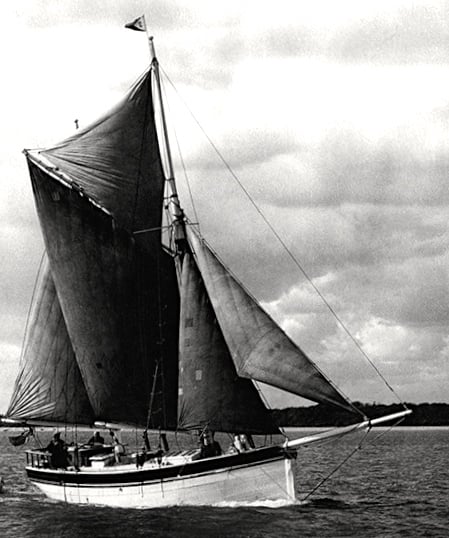
Saoirse under her original ketch rig in the 1950s, but with a boom fitted to the mainsail. Conor O'Brien had a loose-footed mainsail, and as evidenced here, the sail would have set much better but would have needed more attention in handling. (From a photo by Eric Hiscock)

In dry dock during the 1950s, Saoirse's "cod's head & mackerel tail" hull shape is clearly seen. Yet in the Great Southern Ocean on her voyage round the world south of the Great Capes, this bluff little 42ft ketch regularly logged 180 miles a day in comfort.
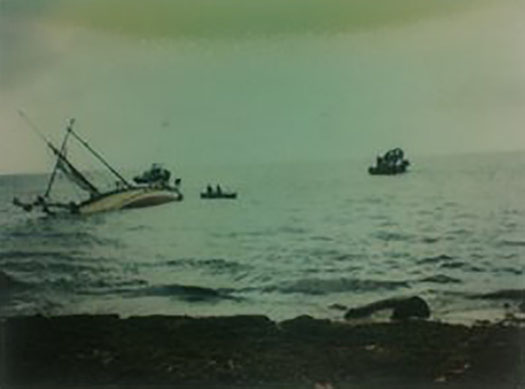
The wreck of the Saoirse in Jamaica, 1979.
Thus when the news in 1979 of Saoirse's destruction in a hurricane in Jamaica was confirmed, if anything it added to the legend. But it also meant that the only other boat created by the same team in the same place – the 56ft trading ketch Ilen (1926) – acquired added significance. But she was a long way away, still working the stormy seas around the Falkland Island, for which she'd been built after the islanders had been so impressed by the capabilities of the Saoirse, when she called there after rounding Cape Horn from the west, that they ordered a bigger sister-ship to become the inter-island workboat .
Yet thanks to a totally single-minded approach by Gary MacMahon of Limerick, Ilen was brought back to Ireland in 1998. And though it has taken quite a while for the various ideas to become reality, she is now well on the way to what has become a very public restoration with Liam Hegarty at Oldcourt Boatyard near Baltimore, while the Ilen Boatbuilding School in Limerick has become part of the fabric of Shannonside life, building not only the deckhouses and spars for Ilen herself, but an interesting selection of smaller boats ranging from traditional Shannon gandelows to the new CityOne sailing dinghies.
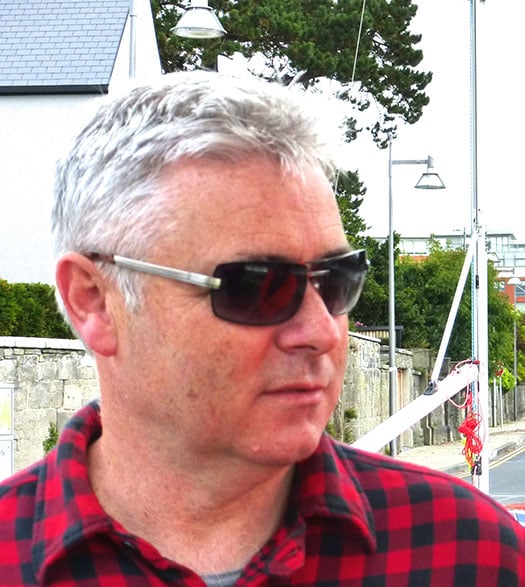
A man who just doesn't give up. Gary MacMahon of the Ilen School in Limerick. Photo: W M Nixon
By any standards, all these projects would be remarkable achievements in themselves. But in addition to his day job running one of Limerick's leading design studios, Gary MacMahon has for twenty years and more been quietly accumulating every bit of documentation of all sorts there is to be found relating to Saoirse.
It's an absolute treasure hoard of old photographs, certificates, plans, artefacts and other materials. And through this collecting, he has become well acquainted with Anthony Bolton who was Saoirse's last owner. Bolton had the misfortune of seeing his beloved boat destroyed by a hurricane in Jamaica before rescue attempts could save her after she'd dragged her anchor and gone ashore.
But though Saoirse was broken up by the battering of the hurricane, substantial pieces of her remained on the sea bed, and two sea-worn iron hanging knees – lovingly fitted by the Baltimore shipwrights 93 years ago – have recently been confirmed as definite relics of the wonderful little ship.
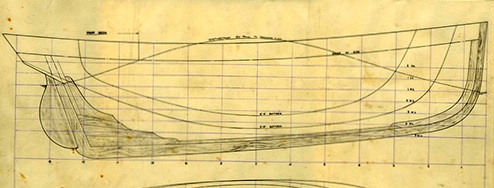
The hull lines of Saoirse as taken off by Uffa Fox in Cowes in 1927 before the start of that year's Fastnet Race (from which she retired, as endless windward work was not what she was designed for). Thanks to documentation of this quality, it will be possible to re-build Saoirse with precision. But in fact it has emerged that, such was the skill of Tom Moynihan and his boatbuilders in Baltimore in 1922-23, Saoirse as built very accurately followed the original lines drawn by O'Brien and Moynihan.

Saoirse's hull sections as recorded by Uffa Fox in 1927.
More importantly, though, the word is that much of the keel may still be intact. So just as he somehow got himself to the Falkland Islands to buy Ilen back in 1997, Gary MacMahon will shortly be going on the much easier journey to Jamaica for some real on-the-spot research as to just how much of Saoirse survives.
These days, it need only be a very small piece of the original to count as a re-build. But the spirit of the Ilen School is such that even if they find nothing at all in Jamaica, the notion of re-creating Saoirse is gaining so much traction, with that great shipwright Liam Hegarty among those totally taken with the idea of seeing Conor O'Brien's characterful little masterpiece sail again, that already the idea has acquired its own momentum.
But there'll be time enough when winter comes around again to give proper attention to the full range of Saoirse material which Gary MacMahon has amassed in order to ensure an authentic re-build. Meanwhile, this weekend may be seeing the new classic and traditional boat season kick into action in Baltimore, but already things are well under way in France, with last week's huge gathering in the Morbihan on the Biscay Coast, to which seven Dublin Bay Waterwags travelled, and eight returned.
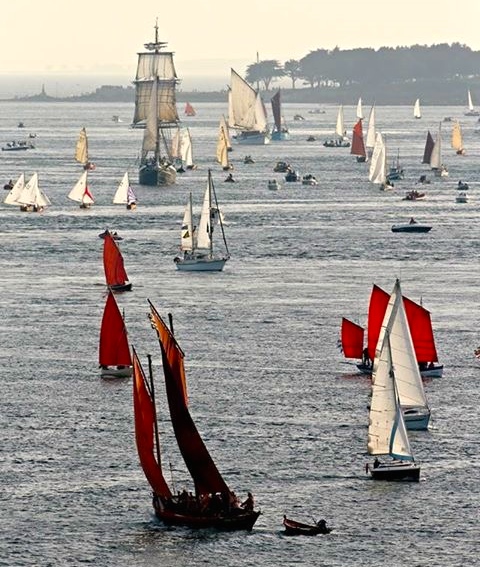
The wonders of the Morbihan. A very small part of the fleet at the Sailing Week eight days ago, with four of the Dublin Bay Water Wags at mid left. Photo: Courtesy Judith Malcolm
Like all the great French classic and tradboat festivals, the Morbihan event (it's full title is La Semaine de la Voile du Golfe de Morbihan, that's Morbihan Sailing Week in simple English) was mind-bending in terms of numbers, with 1200 boats of all shapes and sizes taking part. But the scale and layout of the Morbihan is such that it could well cope. The extensive inlet has six main ports, so the fleet was divided into six sub-groups of around 200 boats each. Everyone mingled out on the water during the day, then each night of the week-long festival saw your group going to a new port.
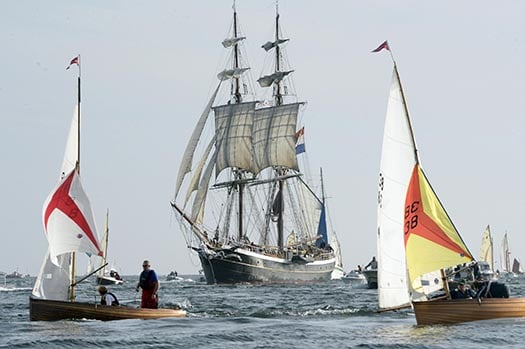
Two little Water Wags a long way from home – Ian & Judith Malcolm in the hundred year old Barbara (left) and Guy and Jackie Kilroy in Swift (right) in the midst of "sundry boats" in the Morbihan eight days ago. Photo courtesy Judith Malcolm
It worked, and it worked so well that the Irish flotilla of one Shannon One Design (Reggie Goodbody) and seven Water Wags not only had themselves a fine old time, but in a reversal of the usual story where our people return from distant places short of a boat or two, they came back with eight Wags, as Adam Winkelmann was united with his new boat. It was built in France as a boat-building academy exercise with a finish so exquisite that it was on exhibition in a marquee, but he was allowed to bring it home with him to Dublin Bay.
Far to the southwest in Baltimore, today we'll see a complex programme, as several traditional rowing craft (including a 23ft traditional Shannon cot or brochaun, the latest creation of Limerick's Ilen School built by a team headed by Tony Daly) were due to launch last night to berth at the pontoon in Skibbereen beside the West Cork Hotel. Today at 11am they start a rowing race all the way down the Ilen to Baltimore. Fortunately, the tide is ebbing.....
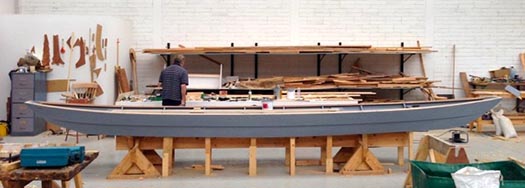
The new 23ft Shannon cot or brochaun is the latest creation of the Ilen School in Limerick. The cot's usual task was to head upriver from Limerick to fish, but today this boat will be rowed down the River Ilen from Sibbereen to the Baltimore Woodenboat Festival.
The rest of the day will see sailing and rowing races off Baltimore with a prize-giving dinner tonight in Baltimore Sailing Club presided over by Tom MacSweeney of this parish, then tomorrow (Sunday), as the one day Seafood Festival gets into full swing, there's perhaps the most interesting event of all afloat. This is the Pilot Race, in which the sailing boats put out to sea, and then turn and approach the harbour to be met by racing gigs each of which has to put a pilot on board one of the sailing craft which then race back into the harbour – it all makes for mighty sport.

Bowsprits at the ready, and the island ferry coming into port – it can only be Baltimore at Woodenboat Festival time
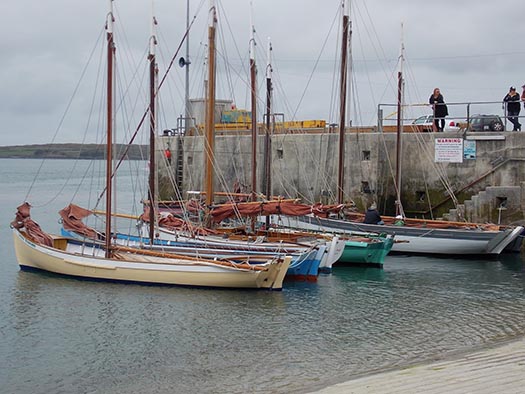
If you can identify even half of the boat types here, then you should be in Baltimore this weekend.
If your heart is with classic and traditional sailing boats, you can get an abundance of them by being in Baltimore this weekend, and then by being along Dublin's Liffey for the Riverfest in a week's time for the Bank Holiday weekend. It's a three day event (May 30th to June 1st) based on Poolbeg Y & BC, with the Old Gaffer's Leinster Trophy Race in Dublin Bay on Saturday, and then two days above the bridge for all sorts of city festivities and boat parades through to Monday evening.

The 117-year-old Howth 17s will be returning to the Dublin Riverfest in a week's time. Photo: W M Nixon
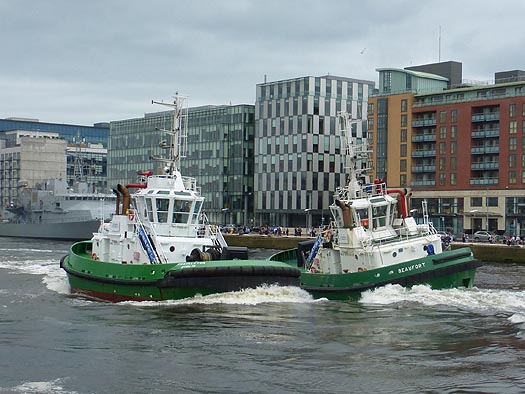
The famous waterborne ballet of the Dublin Port tugs Shackleton and Beaufort will be a main event in the Dublin Riverfest over the Bank Holiday Weekend of May 31st-June1st. Photo: W M Nixon
Following that, on Saturday 6th June out in Howth, the Classic Lambay Race is being provided within the annual Round Lambay Regatta (it dates back to 1904), with the Old Gaffers and Traditional boats joining the 117-year-old Howth Seventeens for a direct circuit from a pier start out to Lambay, round it and back again direct, with no fancy special mark rounding in between.
Defending champion in the Classic Lambay is OGA International President Sean Walsh of Dun Laoghaire with his cutter Tir na nOg, and extra interest is added this year as the fleet will include Dickie Gomes' 1912-vintage 36ft yawl Ainmara, built in Ringsend but now a longtime resident of Strangford Lough. There's a certain edge to Ainmara's involvement, as she was overall winner of the cruiser division in the 1921 Lambay Race when still owned and sailed by her designer-builder John B Kearney. But if you think this remarkable historic link will cause her opponents to give her an easy time of it, you're much mistaken.
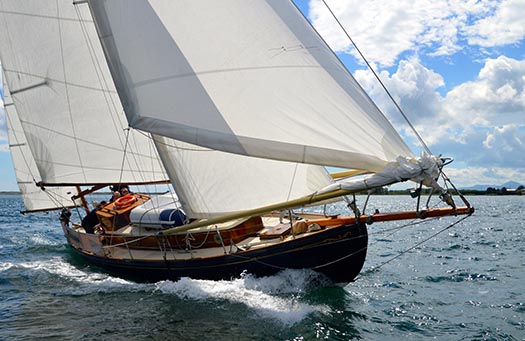
The 103-year old Ainmara – seen here on her home waters of Strangford Lough with the Mourne Mountains in the distance – will be returning to the Lambay Classic at Howth on June 6th 2015, which she last won in 1921. Photo: Pete Adams
Sean Walsh is having a busy year of it, as his duties as OGA President take him hither and yon, while Tir na nOg will be flagship for the OGA Cruise-in-Company which will follow the big one of 2015, the Glandore Classics Regatta from July 18th to 24th.
But for this weekend, he's in his home waters of Dublin Bay on a venture which means a lot to him, the OGA Youth Sailing Project at Poolbeg under the direction of Liam Begley. It's for youngsters who might not otherwise get a chance to sail. They're taken out to learn the ropes aboard two fine gaff cutters, the Clondalkin Community group's majestic Galway Bay hooker Naomh Cronan, and the OGA President's own Tir na nOg.
When we remember that many folk head from Dublin towards Cork to go sailing, it's intriguing that in this case the young people have come the other way, as they're a group from Mayfield Community School which has eternal fame through being the old school of Roy Keane.
The tyro sailors from Mayfield – there's nine of them, all in the 15-16 age group - have already become boat-acquainted through the Meitheal Mara Community Boatyard in Cork city. But the outing to Dublin puts a different spin on it all, as the first stage is devoted literally to teaching them the ropes, then after the sailing programme is completed out in the bay, the shift in skills is demonstrated by command of the two gaff cutters being given over to the Mayfield crews, who then have to sail them back to port.

OGA President Sean Walsh (top right) with Junior Gaffers from Mayfield Community School in Cork aboard Tir na nOg in Poolbeg in Dublin. Photo: John Galloway
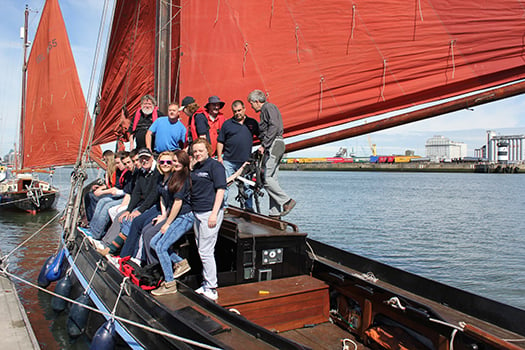
Junior Gaffers from Cork and Senior Gaffers from Dublin aboard the Naomh Cronan Photo: John Galloway
In all, it's an entertaining balance between an outing to Dublin, a chance to learn in a fun environment, and a real opportunity to demonstrate that practical skills have been well and truly acquired. And before somebody is driven to send in a rude comment after seeing these two photos of last year's Youth Sailing Project course, I hasten to assure you that when they do go sailing, everyone wears a lifejacket.
Surprise Basking Shark Features In Cape Clear Documentary
#MarineWildlife - Do you remember the basking shark that surprised a group of bathers off Cape Clear last summer?
According to TheJournal.ie, it's now featured in a documentary shot on the fly by a team of quick-thinking filmmakers.
Aonrú, a film funded by Cork County Council and Bord Iascaigh Mhara, tackles the delicate subject of the West Cork island's future after the decline of the regional fishing industry.
But in the process of filming, they happened to be close by when the basking shark - the second-largest fish in the oceans – made its appearance, the solitary beast almost a metaphor for the island's dwindling community.
TheJournal.ie has more on the story HERE.
#WestCork - A West Cork TD has welcomed the recent announcement of the near €18 million Fishery Harbour and Coastal Infrastructure Capital Programme.
As previously reported on Afloat.ie, the package announced last month by Marine Minister Simon Coveney is primarily aimed at safety, maintenance and development works at Ireland's six Fishery Harbour Centres.
Funded alongside electrical upgrading and more at Castletownbere Fishery Harbour Centre (€890,000) will be storm damage repairs works and improvements infrastructure at Cape Clear's North Harbour at a cost of nearly €2 million.
The funding allocation for these West Cork harbour sites was welcomed by local Fine Gael deputy Noel Harrington, who told the West Cork Times that the works at Cape Clear "will enhance the safety for those living on the island and the thousands who visit there each year."
Moreover, the Castletownbere works are "welcome and necessary in the busy port," he said, adding that he was confident further funding via Cork County Council would see greater investment in the West Cork coastal region.
#TitBonhomme - RTÉ News reports that the families of two Egyptian fishermen who died in the Tit Bonhomme tragedy in West Cork three years ago last week settled their civil actions in the High Court.
Saled Mohamed Ibrahim Aly Eldin and Attia Shabaan were two of four Egyptian fishermen on the Union Hall fishing trawler that sank after running aground in rough seas near Adam's Rock at Glandore Harbour on 15 January 2012.
The incident took the lives of skipper Michael Hayes and fellow crew Kevin Kershaw, whose family settled an action in early 2013, and Wael Mohamed, whose family settled their own High Court action earlier this month.
The latter's brother Abdelbaky Mohamed was the only survivor, and gave testimony at the inquest into the incident in the summer of 2013, which returned verdicts of accidental death. RTÉ News has more on the story HERE.
Hayes' widow Caitlin Ní Aodha has since returned to the fishing industry and spoke to our own Tom McSweeney for his This Island Nation show in October last year.
First Basking Sharks Of 2015 Spotted Off West Cork
#MarineWildlife - The first basking shark sightings of 2015 were logged earlier this month, as Ireland's Wildlife reports.
Bridget Healy spotted two of the ocean's second-largest fish from the shore at Ardfield, near Clonakilty in West Cork last Monday 9 March – a little earlier than they usually appear.
But it's still some time off their peak numbers expected between May and June, when the gentle giants might come closer to the shore like one did in Cork Harbour last summer.
Ireland's Wildlife has more on the story HERE.
Retired Teacher Drowned After Sailboat Overturned, Inquest Hears
#Zillah - The inquest into the death of a retired schoolteacher in a sailing accident off West Cork last summer has heard he was "very safety conscious".
As previously reported on Afloat.ie, the body of 66-year-old Douglas Perrin was recovered from the water near Sherkin Island on the morning of 14 August 2014 after a 12-hour search and rescue operation.
Coroner Frank O’Connell returned a verdict of accidental death, noting the cause of death as acute cardiac failure brought on by drowning.
Two companions, Marian Brown and Patrick Anwyl, were found alive on nearby Castle Island after swimming away from the capsized sailboat the three had been travelling in the day before.
Bandon Courthouse was told that Perrin had purchased his boat Zillah, a 24ft Drascombe Lugger, two years before retiring from Oxfordshire to Goleen in Co Cork in 2013, according to the Irish Examiner.
The party – each with a lifejacket – had set out for a short excursion at 4pm, planning to return in time for a 7pm dinner, when the boat overturned under the control of Anwyl in gusty weather.
"We were about 50 yards from an island, collectively we discussed it and started to swim," read a statement from Brown, who added that when the swell subsided, she and Anwyl managed to clamber onto the rocks, from where they saw Perrin "lying passively in the water, just drifting."
Later, Brown recalled an Irish Coast Guard helicopter sweeping the area with its search beam but failing to spot the pair, who were eventually met by crews from the Schull inshore lifeboat and Baltimore RNLI the following morning.
The Irish Examiner has more on the story HERE.
Simon Coveney to Nail 'Ilen's' Whiskey Plank at West Cork Ceremony for Ireland's Last Traditional Sailing Ship
#ilen – Simon Coveney T.D. Minister for Agriculture, Food & The Marine and Minister For Defence will hammer home the final 'whiskey plank' of European larch on the hull of the good ship Ilen on Monday, 16th February.
The whiskey plank is the final crafted plank nailed to the hull of a wooden sailing ship. It is a significant milestone in the build and is traditionally marked by a celebration.
The Ilen is the last of Ireland's traditional sailing ships. Built in 1926, it was delivered by Munster men to the Falkland Islands where it served valiantly for seventy years, enduring and enjoying the Roaring Forties, the Furious Fifties, and Screaming Sixties.
Returned now to Ireland and given a new breath of life with powerful ribs of grown Irish oak, and long planks of European larch from our gallant allies in the Bavarian Alps, she pitches impatiently in the trammels of the great Corn Store in Hegarty's Boatyard, as eager as a young salmon to get to the sea.


























